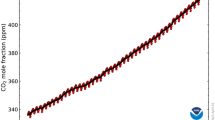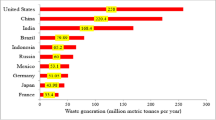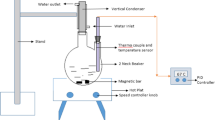Abstract
Municipal solid waste incinerator (MSWI) fly ash contains large amounts of arsenic and antimony. This study focuses on the incorporation and evaporation of arsenic and antimony when MSWI fly ash added to clinker raw meal. Thermal analysis was used to simulate the “single incorporation” of arsenic and antimony into clinker with HSC. Statistical analysis was acquired by cement industrial monitoring data to determine the effect of total chloride, arsenic and antimony input on the incorporation or evaporation of arsenic or antimony. A simplified mass balance model was used to evaluate the effect of cement kiln dust (CKD) recirculation on the “multiple incorporation” of arsenic and antimony in clinker and the evaporation of arsenic and antimony in waste CKD. The results indicated that arsenic and antimony was largely incorporated into the clinker as Ca2(AsO4)2(s), even in the presence of chlorides. Moreover, CKD recirculation promoted arsenic and antimony incorporation into clinker.







Similar content being viewed by others
Abbreviations
- m:
-
Mass
- rm:
-
Recirculation ratio of cement kiln dust
- ME:
-
Mass of arsenic
- R:
-
Mass ratio of As in cement kiln dust to total arsenic
- RC:
-
Recirculation ratio of arsenic in cement kiln dust
- mswifa:
-
MSWI fly ash
- coa:
-
Coal
- raw:
-
Cement raw meal
- ckd:
-
Cement kiln dust
- ckdw:
-
Waste cement kiln dust
- ckdr:
-
Cement kiln dust recirculation
- clk:
-
Clinker
References
Ryunosuke, K.: Recycling of municipal solid waste for cement production: pilot-scale test for transforming incineration ash of solid waste into cement clinker. Resour. Conserv. Recycl. 31, 137–147 (2001)
Saikia, N., Kato, S., Kojima, T.: Production of cement clinkers from municipal solid waste incineration (MSWI) fly ash. Waste Manag. 27, 1178–1189 (2007)
Shih, P.H., Chang, J.E., Chiang, L.C.: Replacement of raw mix in cement production by municipal solid waste incineration ash. Cem. Concr. Res. 33, 1831–1836 (2003)
Qiao, L. S.: Several problems about utilizing waste in cement plant (2)-Behaviors of trace metals in cement rotary kiln [J]. Cement 12, 1–8 (in Chinese)
Barros, A.M., Tenório, J.A.S., Espinosa, D.C.R.: Chloride influence on the incorporation of Cr2O3 and NiO in clinker: a laboratory evaluation. J. Hazard. Mat. B93, 221–232 (2002)
Barros, A.M., Tenório, J.A.S., Espinosa, D.C.R.: Evaluation of the incorporation ratio of ZnO, PbO and CdO into cement clinker. J. Hazard. Mat. B112, 71–78 (2004)
Ract, P.G., Espinosa, D.C.R., Tenório, J.A.S.: Determination of Cu and Ni incorporation ratios in Portland cement clinker. Waste Manag. 23, 281–285 (2003)
Andrade, F.R.D., Maringolo, V., Kihara, Y.: Incorporation of V, Zn and Pb into the crystalline phases of Portland clinker. Cem. Concr. Res. 33 63–71 (2003)
Stephan, D., Maleki, H., Knöfel, D., Eber, B., Härdtl, R.: Influence of Cr, Ni, and Zn on the properties of pure clinker phases Part II. C3A and C4AF. Cem. Concr. Res. 29 651–657 (1999)
Stephan, D., Maleki, H., Knöfel, D., Eber, B., Härdtl, R.: Influence of Cr, Ni, and Zn on the properties of pure clinker phases Part I. C3S. Cem. Concr. Res. 29 545–552 (1999)
Stephan, D., Maleki, H., Knöfel, D., Eber, B., Härdtl, R.: High intakes of Cr, Ni, and Zn in clinker Part II. Influence on the hydration properties. Cem. Concr. Res. 29 1959–1967 (1999)
Stephan, D., Maleki, H., Knöfel, D., Eber, B., Härdtl, R.: High intakes of Cr, Ni, and Zn in clinker Part I. Influence on burning process and formation of phases. Cem. Concr. Res. 29 1949–1957 (1999)
Kakali, G., Parissakis, G.: Investigation of the effect of Zn oxide on the formation of Portland cement clinker. Cem. Concr. Res. 25(1) 79–85 (1995)
Heart, S.: Use of cement kilns in managing solid and hazardous wastes: implementation in Australia [D]. Griffith University, Gold Coast (1994)
Zhu, G. Z.: Study on using cement turning kiln to incinerate hazardous waste along with cement materials [J]. Acta Scien. Circum. 20(6):810–812 (2000) (in Chinese)
Li, M., Xiang, J., Hu, S., Sun, L.S., Su, S., Li, P.S., Sun, X.X.: Characterization of solid residues from municipal solid waste incinerator. Fuel 83(10), 1397–1405 (2004)
Liu, F., Liu, J.G., Yu, Q.F., Jin, Y.Y., Nie, Y.F.: Leaching Characteristics of heavy metals in Municipal Solid Waste Incinerator Fly Ash. J. Environ. Sci. Health 40(10), 1975–1985 (2005)
Maria Z, Jana B, Ingrid H. The utilization of modified BCR three-step sequential extraction procedure for the fractionation of Cd, Cr, Cu, Ni, Pb and Zn in soil reference materials of different origins (J). Talanta 70, 973–978 (2006)
Kazi, T.G, Jamali, M.K, Kazi, G. H, et al.: Evaluating the mobility of toxic metals in Untreated industrial wastewater sludge using a BCR sequential extraction procedure and a leaching test (J). Anal Bioanal Chem. 383, 297–304 (2005)
Zhang, J., Liu J., Li C., Nie Y., Jin Y.: Comparison of the fixation of heavy metals in raw material, clinker and mortar using a BCR sequential extraction procedure and NEN7341 test. Cem. Concr. Res. 38, 675–680 (2008)
Zhou M., Wu H.: Solidification characteristics and mechanisms of cement treated Pb/Zn contaminated soils from a mining site in Hunan Province, China(J). Int. J. Environ. Pollut. 59, 269–283 (2016)
HSC 6.0 software instruction
Abanades, S., Flamant, G., Gauthier, D.: Kinetics of heavy metal vaporization from model wastes in a fluidized bed(J). Environ. Sci. Technol. 36(17), 3879–3884 (2002)
Zhang, J.: Environmental safety of heavy metals in hazardous waste co-processing in cement rotary kiln (D). Tsinghua University, Beijing (2006)
Wang, L., Jin, Y., Li, R., Nie, Y.: Stabilization of arsenic in waste during co-processing with cement kiln and leaching characteristics of clinker. Huagong Xuebao. 62(3), 816–822 (2011)
Lederer, J., Trinkel, V., Fellner, J.: Wide-scale utilization of MSWI fly ashes in cement production and its impact on average heavy metal contents in cements: The case of Austria(J). Waste Manag. (2016) doi: 10.1016/j.wasman.2016.10.022
Huber, F., Blasenbauer, D.: Thermal co-treatment of combustible hazardous waste and waste incineration fly ash in a rotary kiln(J). Waste Manage. 58, 181–190 (2016)
Zhejiang University: Monitoring report on emissions of mercury, arsenic, selenium and ordinary pollutants from cement kilns in Luzhong/Donghua district, Shandong province [R]. Zhejiang University, (2008)
Guo, Q.: Increases of lead and chromium in drinking water from using cement-mortar-lined pipes: initial modeling and assessment (J). J. Hazard. Mat. 56, 18l–213 (1997)
Guo Q., James, O., Eckert, J. R.: Heavy metal outputs from a cement kiln co-fired with hazardous waste fuels (J). J. Hazard. Mat. 51, 47–65 (1996)
Acknowledgements
We acknowledge the financial support from the National Science Foundation (No. 51108276) and the National Basic Research Program of China (No. 2011CB201500) in China.
Author information
Authors and Affiliations
Corresponding author
Ethics declarations
Conflict of interest
The authors declare no conflict of interest.
Rights and permissions
About this article
Cite this article
Wang, L., Niu, C. & Li, Rd. Prediction of Arsenic and Antimony Behaviour in MSWI Fly Ash During Co-Processing in a Cement Kiln. Waste Biomass Valor 9, 1475–1484 (2018). https://doi.org/10.1007/s12649-017-9832-1
Received:
Accepted:
Published:
Issue Date:
DOI: https://doi.org/10.1007/s12649-017-9832-1




